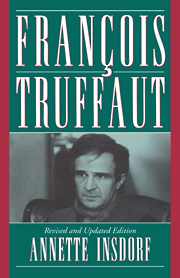Book contents
6 - “Cinema in the First Person Singular”
Summary
The Boy Who Loved Films
The Man Who Loved Women (1977) affirms the continuities and the autobiographical nature of Truffaut's cinema. It centers on a male protagonist whose self-definition implicitly builds upon the first actions performed by Antoine Doinel in The 400 Blows: Bertrand Morane (Charles Denner) decides to write his memoirs after looking at a drawerful of photographs of pretty conquests. Antoine had been caught looking at a picture of a pin-up girl, and his teacher isolated him in a corner where the boy scribbled on the wall,
Here suffered poor Antoine Doinel
Unjustly punished by Little Quiz
For a pin-up that fell from heaven …
Between us it'll be an eye for an eye, a tooth for a tooth.
(400 Blows, 17)The conjunction of looking at a woman and writing a personal declaration—recording the consequences, justifying oneself, and passing on one's experience—begins with Truffaut's first feature and is developed in his sixteenth one. Bertrand takes his place as an extension of Antoine; however, the evolution and implications of this connection can be fully understood only when we realize that Antoine as well as many other characters, themes, techniques, and structures are intimate reflections of François Truffaut.
The 400 Blows (whose French title comes from the idiom, “faire les quatre cents coups”—“to raise hell”) is a chronicle of emotions and events that the director experienced at first hand.
- Type
- Chapter
- Information
- François Truffaut , pp. 173 - 218Publisher: Cambridge University PressPrint publication year: 1995



